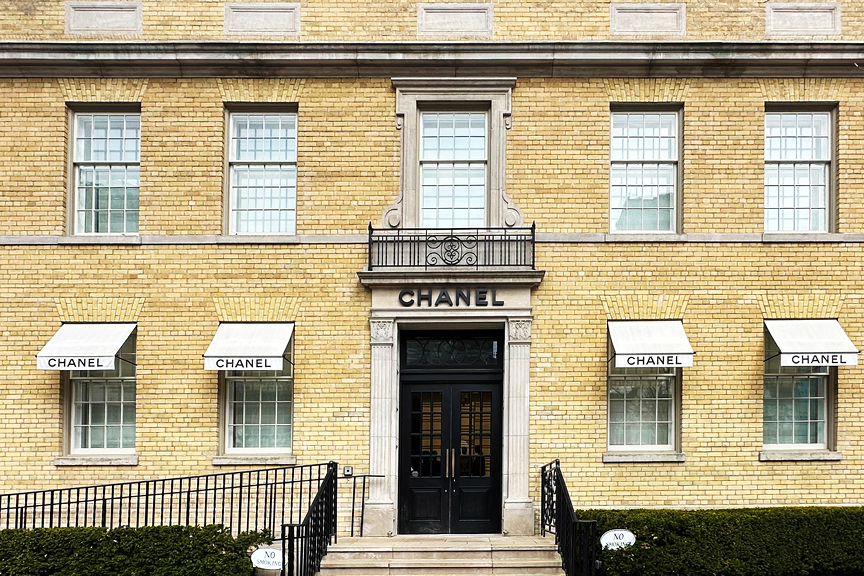Historic Home Design Inspiration
Toronto’s neighborhoods reveal layers of architectural history, evolving styles, and buildings that still feel lived in. My trip north-of-the-border wasn’t just about boutiques and façades; I was studying how old structures adapt over time. From Georgian storefronts to rows of Victorians, the architecture holds its own, even with new signage and modern updates.
In my own work, I’m always looking to preserve what’s already there—the quirks, the craftsmanship, and the details that have lasted more than a century (or longer). At the same time, I’m finding ways to bring in modern life and, when it fits, a more current aesthetic. These photos highlight a few Toronto-style brick buildings—distinct from what you’d find in Boston or New York, and part of what gives the city its own architectural identity in the world of 19th-century design.
High-End Shopping in Toronto: Retail and Restoration
Isaia’s storefront sits on a prominent corner of Yorkville Avenue—right in the heart of the neighborhood. A rare 1867 brick structure—according to a passerby—blends historic architecture with modern retail. Valued at around $5,000 per square foot (a detail I later confirmed after a quick Google), it reflects both Yorkville’s elevated status and the building’s standout character. Its ivy-covered façade softens the strong lines of the Georgian design: a centered entry, evenly spaced windows, and twin chimneys that anchor the roofline. Each window is painted crisp black, framing that standout red door—a detail that stayed with me the rest of the trip.
Next door, the Christian Louboutin boutique sits in a free-standing Victorian structure that serves as the brand’s Canadian flagship. Its vivid red façade matches the signature soles of its shoes, framed by pointy rooflines and ornate trim.
Just across the street is Chanel. Housed in a 1930s yellow brick building, the original façade remains intact—symmetrical windows, a centered stone portico, and refined wrought iron details. Architect Peter Marino created a series of salons inside, each dedicated to a category of product. You’ve got to love Chanel’s approach to architecture: a pristine example of historic preservation seamlessly woven into brand identity—where modern luxury honors architectural heritage.
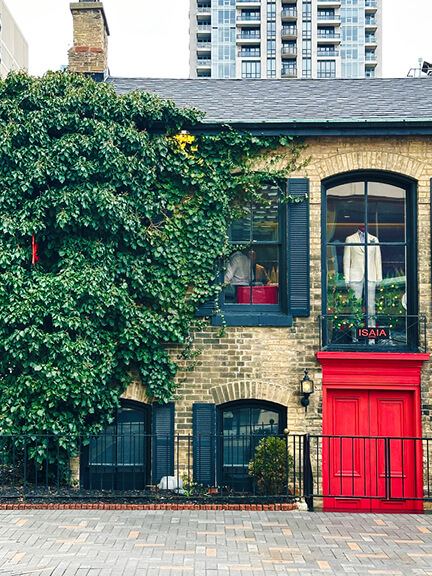
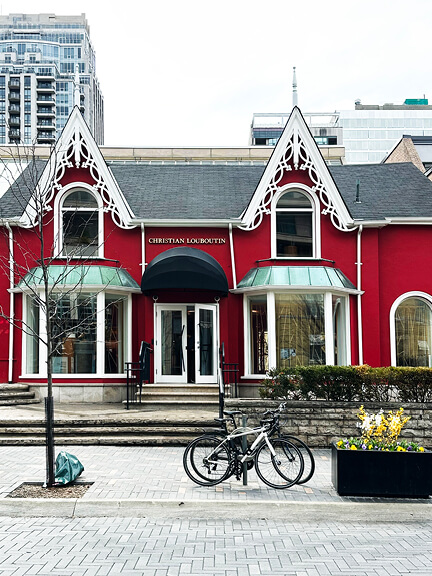
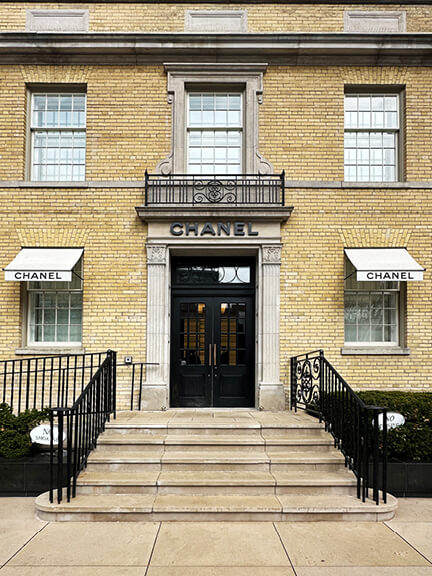
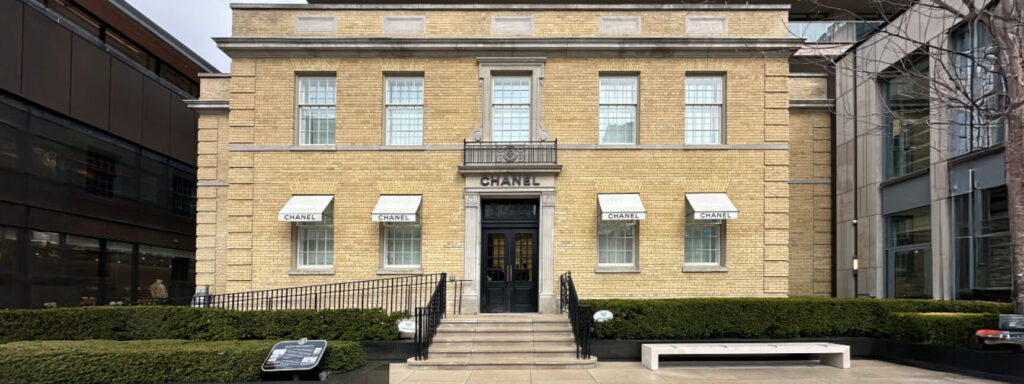
Victorian Semi-Detached Homes
A few blocks away, the streetscape shifts to rows of Victorian semi-detached homes. These structures—typically built between 1860 and 1890—feature pitched gables, decorative bargeboards, and symmetrical facades. Each pair is split cleanly down the center, often painted in contrasting colors to express individuality while preserving overall balance. One such example: a black storefront on the left, a bold red restaurant-bar on the right. The black side has a rounded bay window that curves subtly, while the red side uses a more angular, traditional bay—cousins, not twins.
Further up the street, more semi-detached Victorians emerge. Hazelton House, a three-story brick home, shows off painted trim, black windows, and modernized steps with integrated planters. One standout: a creamy off-white façade with white trim accentuating the steep gables, bringing light and softness to the block. Galleries in the area reflect a more modern take—painted in charcoal or crisp white—standing in contrast to the warm red brick of their neighbors.
These ‘homes’ offer a different take on brownstone design than what you’d find in Boston’s Beacon Hill or South End. While Boston’s brick structures are typically single-family and left as-is, many of these are semi-detached or split—altering the rhythm of the street. You won’t see painted brick in Boston either; the masonry is usually left natural, with minimal changes made to the original windows. I appreciate the mix in Toronto – some natural brick, some painted. Some with modern windows, others with old-school elements.
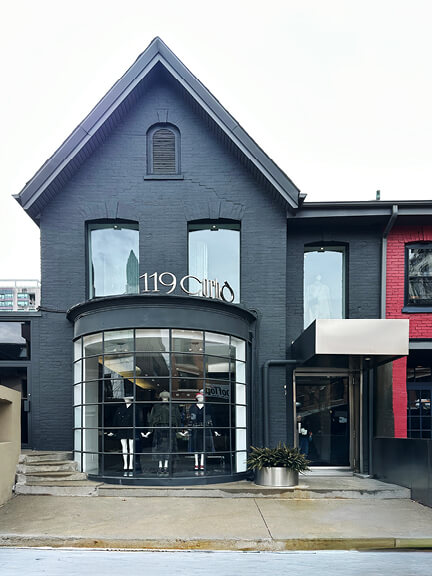
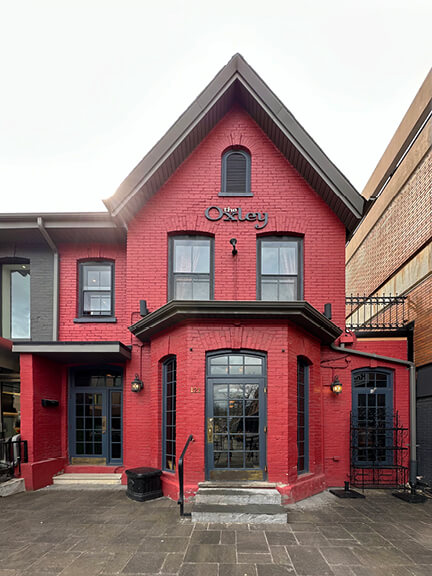
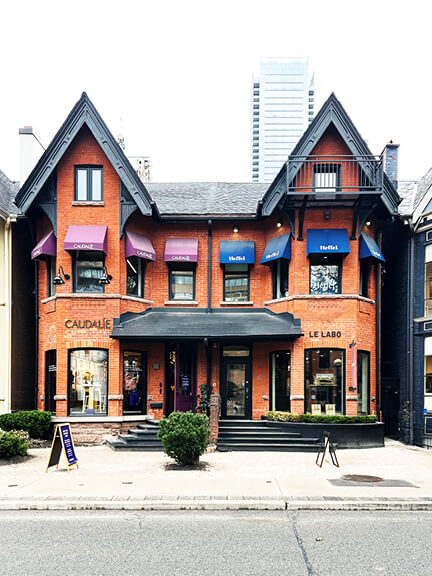

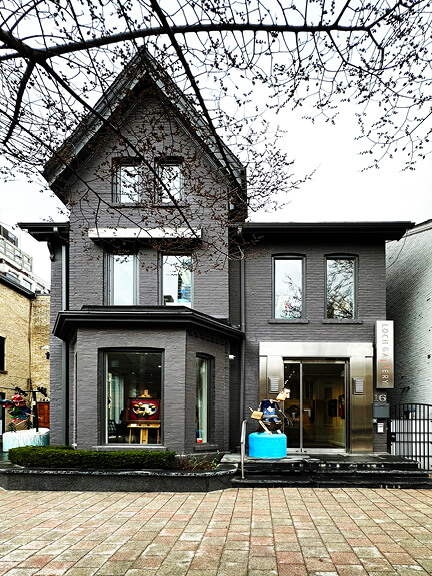
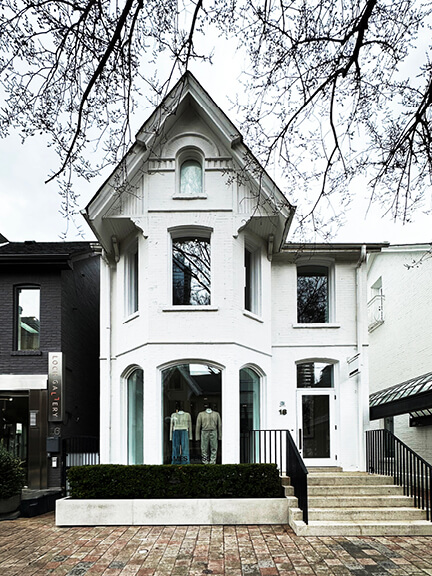
The Webster, Toronto: Glowing Pink
One of my favorites: a soft pink historic building with a singular, steeply pitched roofline and matte black windows. The exterior features custom brass door hardware and simple modern lighting—home of The Webster; a chic retailer widely recognized for its distinctive exterior and interior designs (I’ve been to their LA, NYC, & Miami locaitons too – all unique, all with a pink palette). Inside, herringbone floors meet pink, white, and grey terrazzo in playful, graphic patterns. A glowing pink LED staircase leads to the second floor, where more of the curated collection of high-end clothing awaits. The stair is a stark and modern contrast set against the timeworn texture of the building, creating a tension that’s both deliberate and fun. The lighting alone is nearly impossible to capture—it resists photography and truly has to be seen in person.
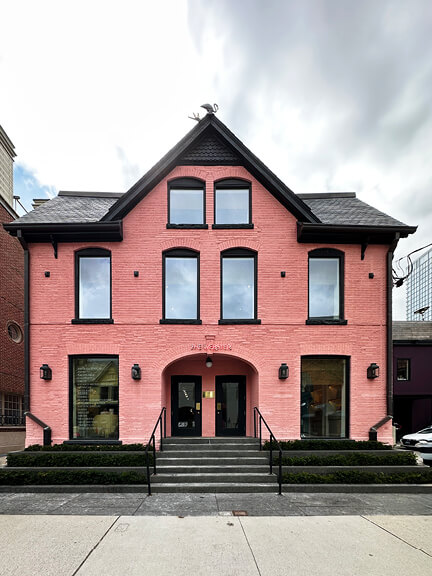
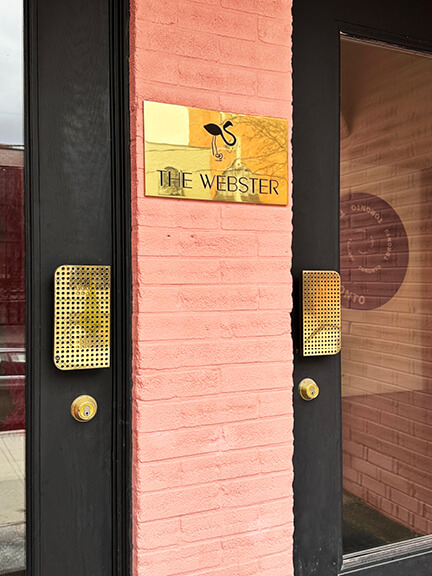
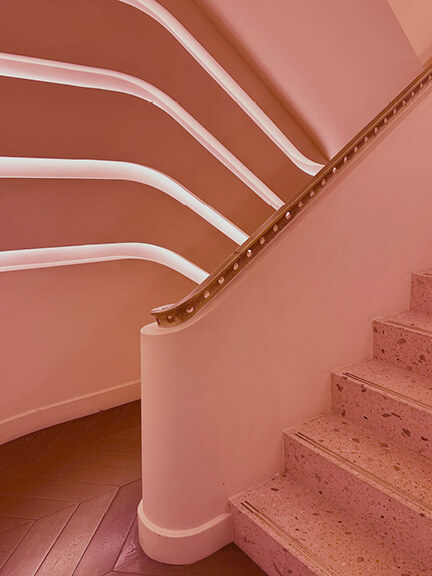
High Victorian Gothic Revival
A standout stretch of Victorian row houses in Yorkville showcases the neighborhood’s late 19th-century charm. Prime examples of High Victorian Gothic Revival architecture, the continuous row includes nineteen two-storey homes built in the early 1880s. Standout details include two-tone brickwork, pointed-arched attic openings, and decorative wooden bargeboards. Mirrored windows and doors create a balanced facade as you experience almost 20 attached homes; a very strong statement.
A row of 19 brownstones is uncommon even by Boston standards, where rows typically max out around 8 to 15. In Yorkville, where most homes are either standalone or built in pairs, this continuous stretch—paired with its distinctive brickwork—stands out as something unique.
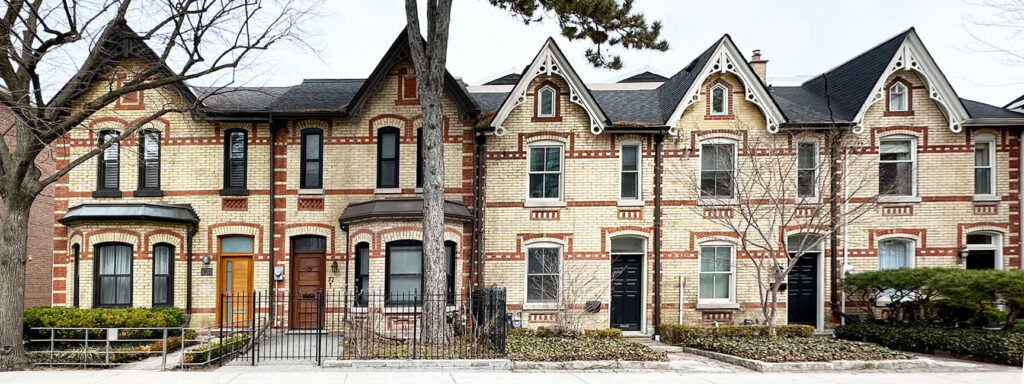
The Annex: Bay-and-Gable Homes
Moving west into ‘The Annex’ neighborhood, Lowther Avenue showcases bay-and-gable homes—large bay windows extending up to the roofline, covering much of the façade. Tapping back into my art history roots—with a bit of help—I identified the general style as Romanesque Revival. Rounded arches, intricate stonework, and heavy masonry all point to the grandeur of the late 19th century.
Heading north along Madison Avenue, Queen Anne Revival takes over: asymmetrical façades, varied surface textures, and more whimsical ornament. One standout feature was a stepped, terraced roofline seen in a couple of homes. Its silhouette bold and geometric, different from the softer turrets and gables seen nearby. A few doors up, a classic circular (and cornered) turret with white railings and columns.
Throughout it all—red brick, white trim, black windows, contrasting rooflines—the cohesion somehow holds. Toronto’s architecture, especially in these pockets, manages to celebrate contrast while staying connected.
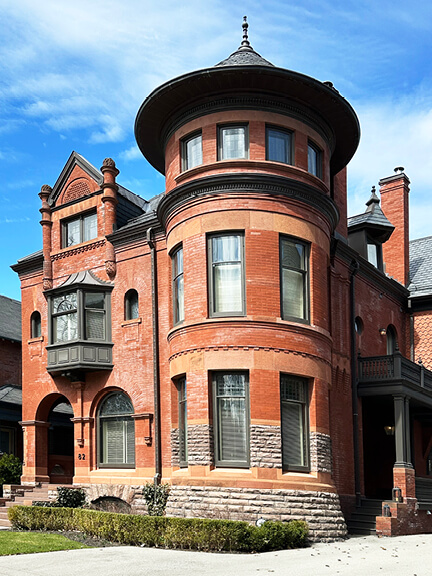
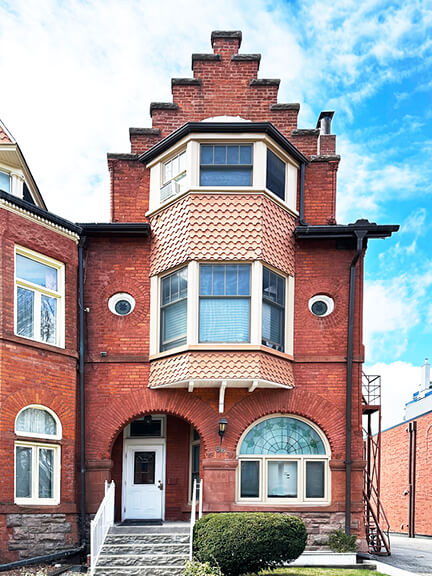
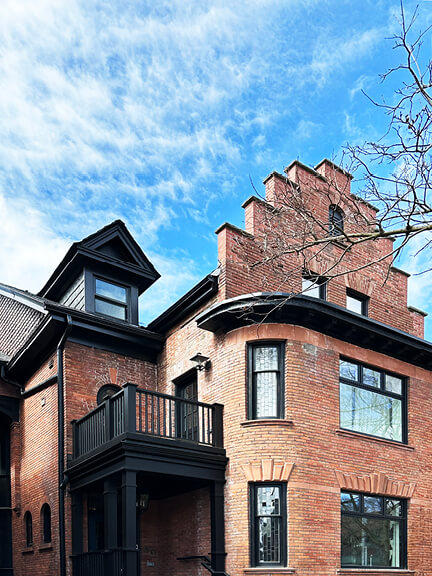
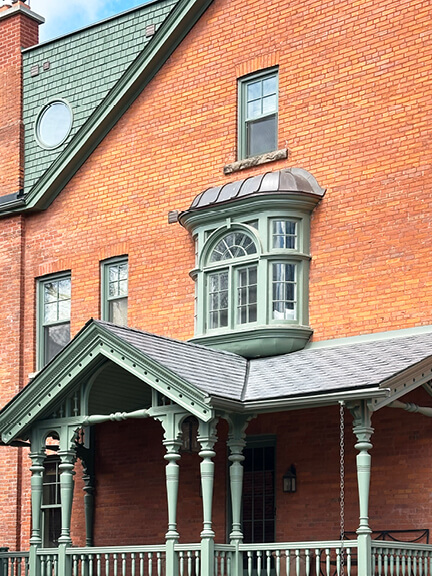
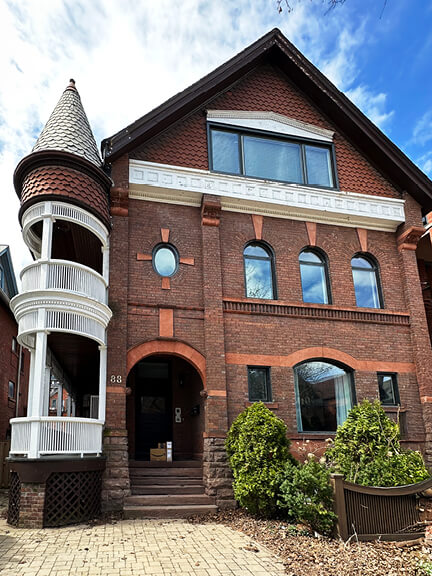
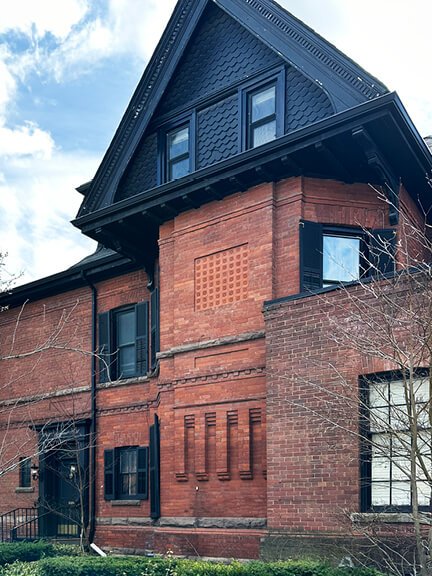
Where to Shop (and Linger) in Rosedale
A charming neighborhood known for its upscale boutiques and laid-back vibe. The main drag, Yonge Street, had a few standout stops. Harvest Wagon was overflowing with fresh spring flowers—classic and full of charm. Sorrel offered a cozy escape, serving French-Mediterranean cuisine in an intimate setting.
Urban Island stood out with its darling pink exterior and beautifully curated selection of homewares, handcrafted linens, and kitchen essentials—many made by Sri Lankan artisans. Clementine’s was another favorite: a refined concept shop offering a mix of luxury fashion and elevated basics.
Don’t miss Narwhal Boutique, which stocks some of my go-to brands like Xiren, The Great, ad Loretta Caponi in that ‘understated-but-polished’ category. Last stop: 1132 Consignment, a treasure trove of pre-owned luxury pieces, beautifully presented.
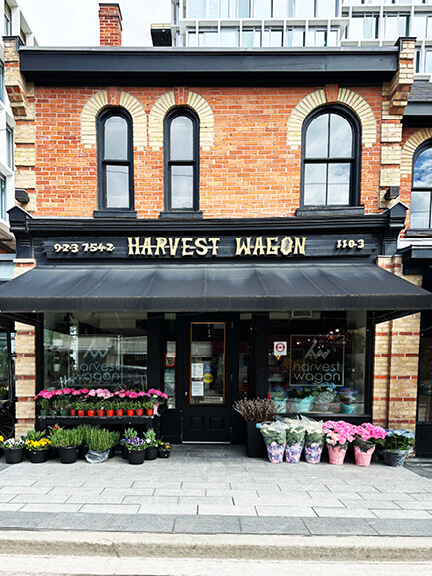

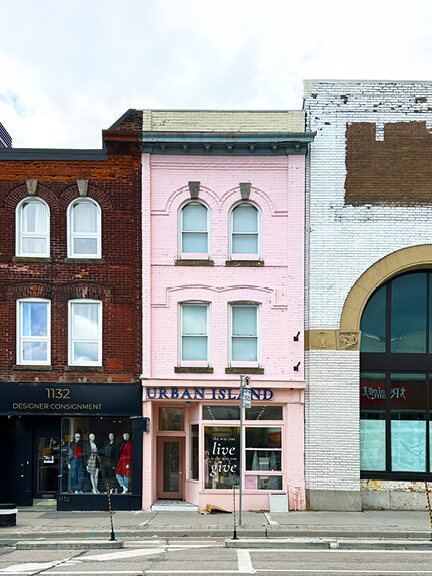
Subtle Shifts in Detail
In Toronto’s Rosedale area, the Summerhill neighborhood shows its history through original brickwork—sometimes painted, sometimes left in its natural red. A white-painted semi with mismatched windows—one side black, the other white—sits neatly beneath a shared black roofline. A few doors down, sage green siding meets untouched red brick, two halves joined by form but defined by color. Farther along, a red brick facade features an unusual oval window, understated but memorable. Each pairing feels specific, not replicated. The neighborhood’s appeal lies in how these historic homes retain their structure while embracing subtle shifts in detail.
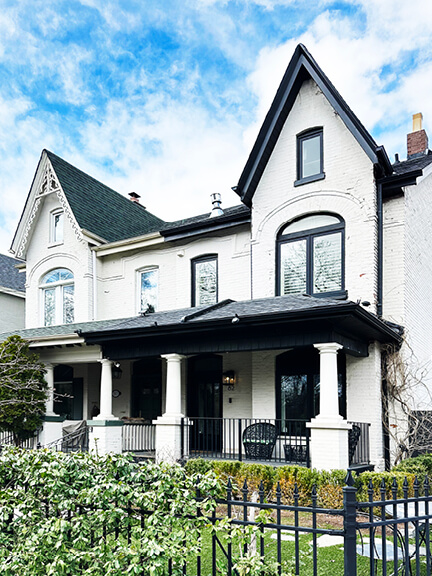
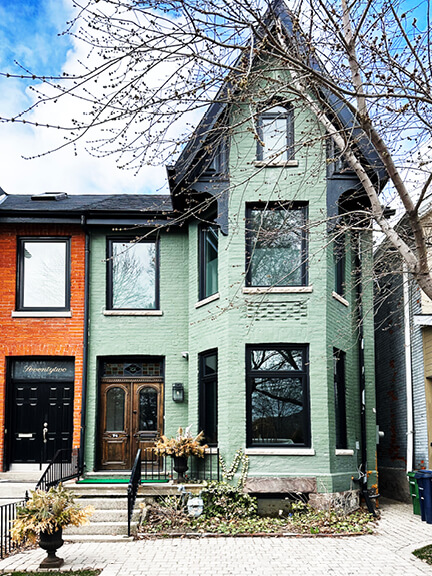
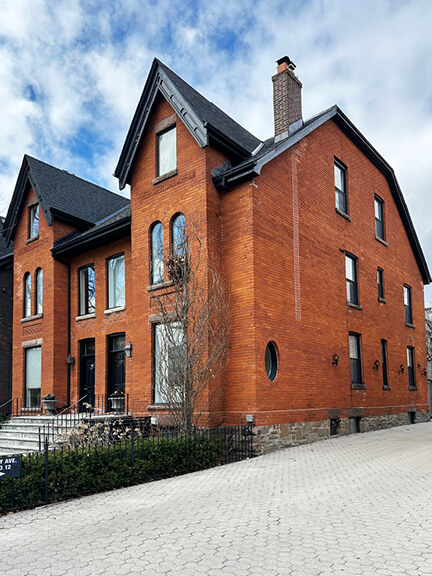
First Impressions
Doors are the first impression—openings that shape how a building is read. Across the city, I kept stopping to capture them, starting with two side-by-side entries on a semi-detached home. They shared a structure but not a language: one framed with concentric squares, the other linear and streamlined. One had etched glass and the other clear glass, both arched in brick above. A seperate home stood out for its ornate woodwork and a circular window—the only one I came across.
Some felt straight out of New England, like a painted dark green door with yellow trim, set against red and yellow brick. A nearby painted facade had a handsome door made of wood, metal, and glass. A soft light blue home contrasted sharply with crisp white millwork—circles and squares still perfectly intact. And then there were the red doors. It started with the one at Isaia in Yorkville, and turned into a series—arched or rectangular, some weathered, some pristine. Paired with natural brick or painted exteriors, each one makes a confident statement.
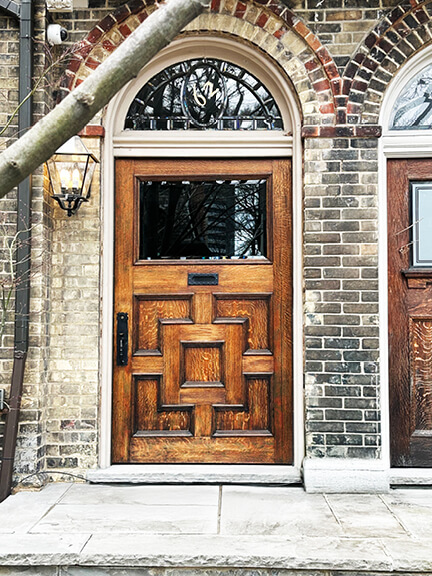
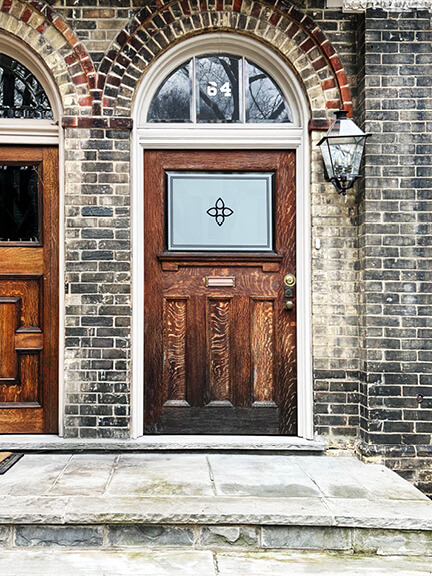
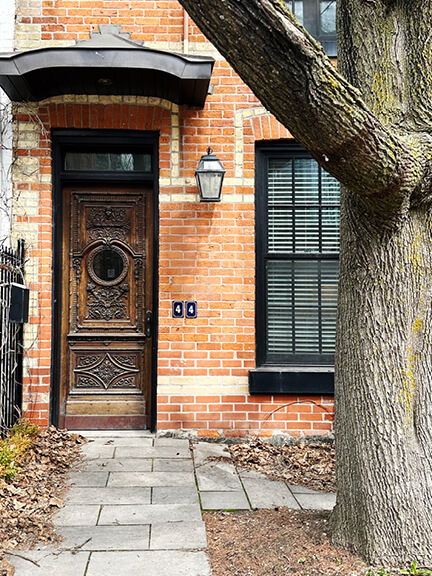
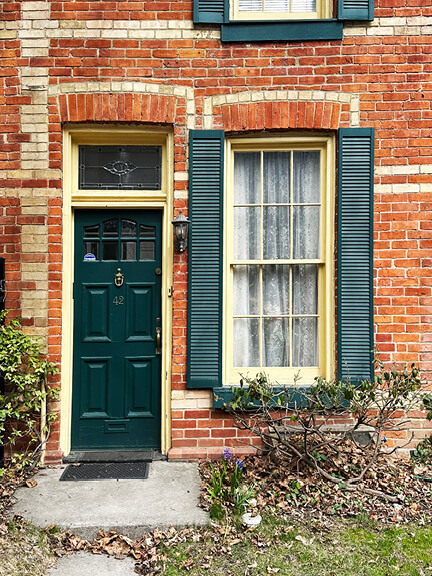
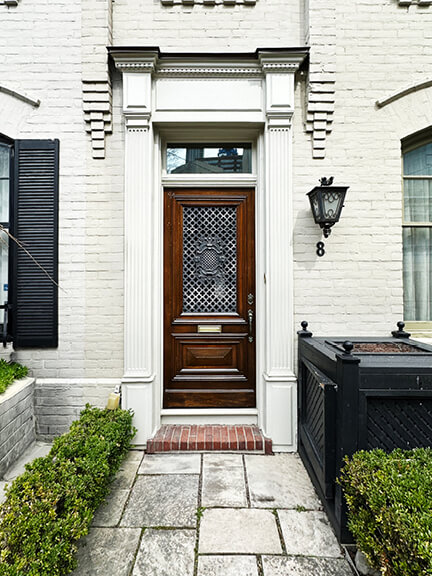
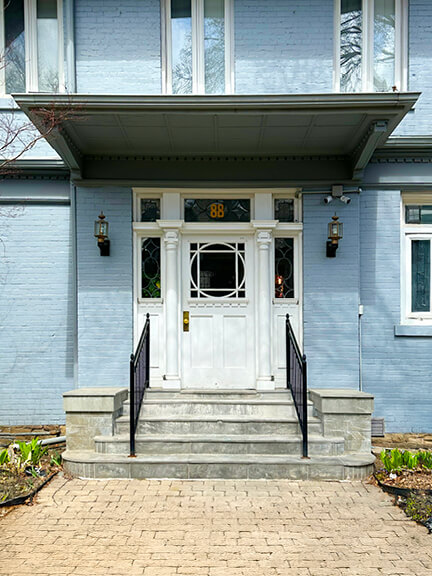
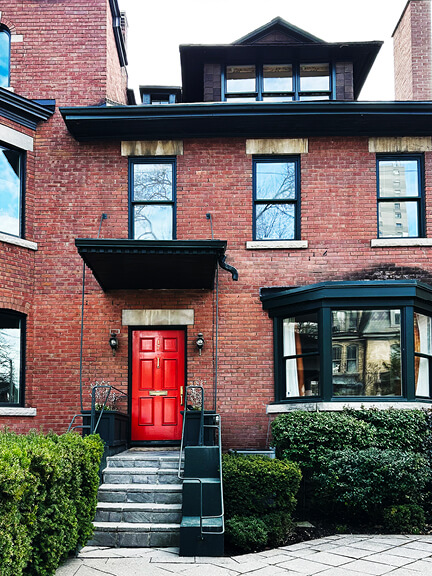
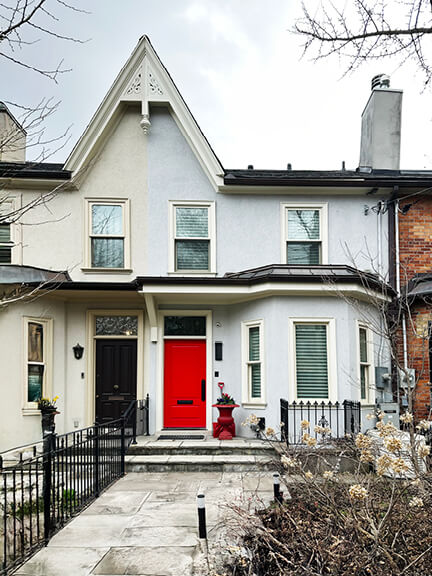
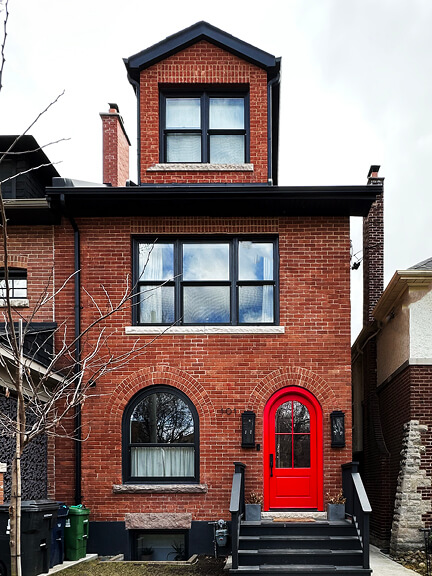
Tudor Revival
Tudor Revival architecture isn’t a major theme in Toronto, but when it shows up, it demands a second look. These homes draw on medieval English references, mostly that unmistakable half-timbered look—wood beams set into stucco or brick, often painted in dark brown or black. One of the few commercial examples is the former Ridpath furniture store, now a school—its decorative half-timbering softened by age and complemented by colorful painted details. Listed on the Toronto Heritage Register, it’s a rare public interpretation of a style most often found in quiet, residential pockets.
In the residential areas, the Tudor look varies. Some façades lean into the classic striped pattern, while others pare it back—applying the design to a single roofline or gable rather than the entire home. It’s less about perfect replication and more about evoking tradition: craftsmanship, history, and a sense of permanence built right into the materials.
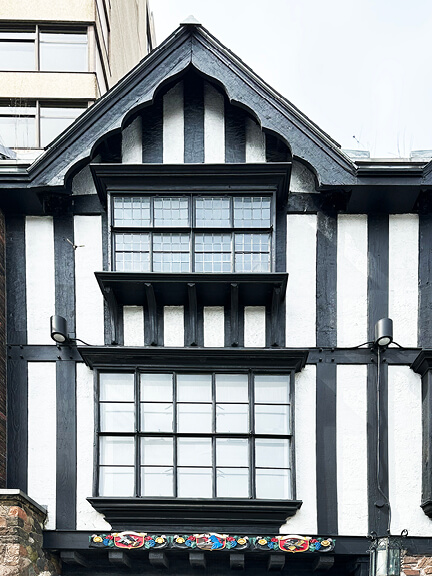
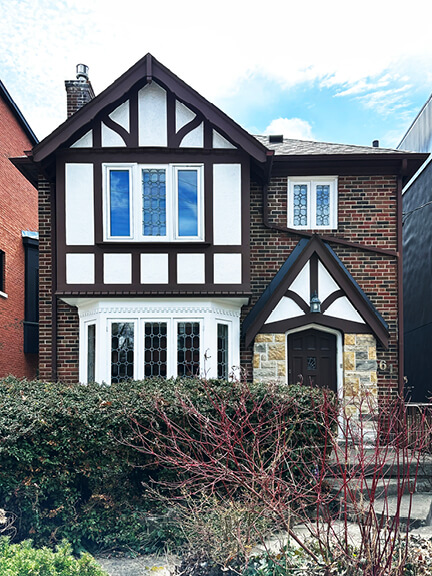
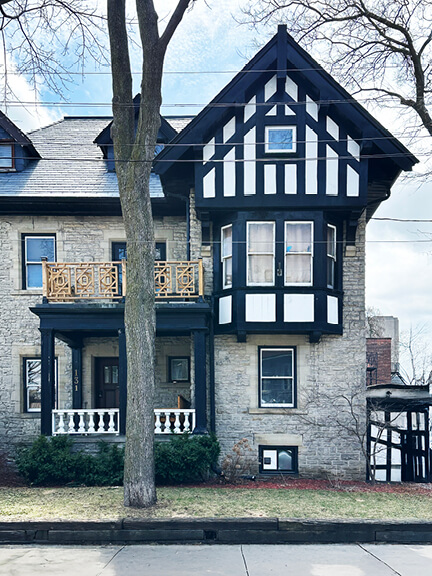
Fire House
Fire Station 312 on Yorkville Avenue holds its own between boutiques and glass towers, with warm yellow brick, orange trim, and a tall clock tower that anchors the block. Above the arched entrance, a historic coat of arms remains in place. The building is still active, quietly existing on a street lined with equally historic structures—peaceful, unless the alarms are going off.
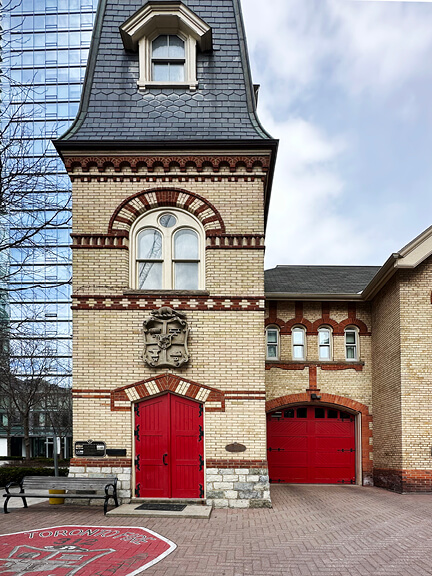
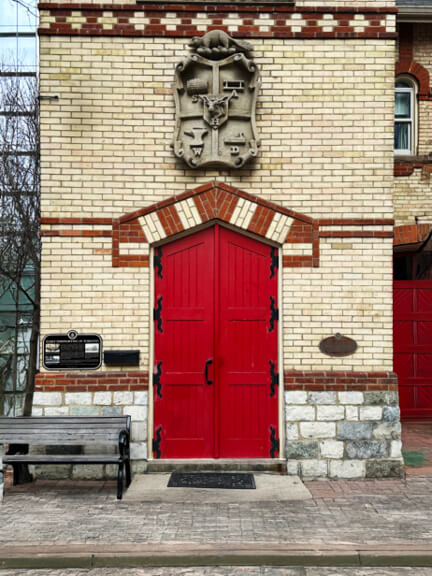
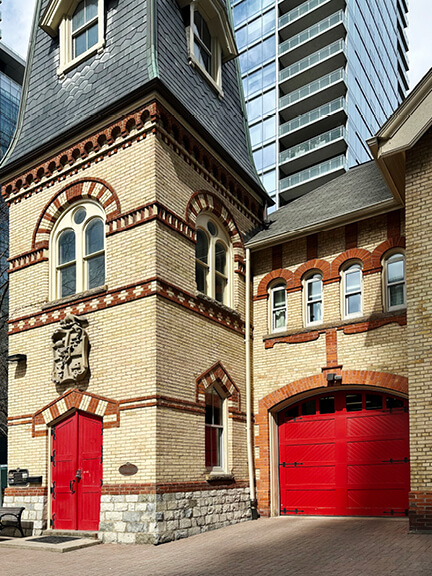
Rosedale Lunch Spot: Manita
By the time I reached Manita, it was the perfect moment to pause. The space is pared-back and warm, with painted tin ceilings, simple globe pendants, and a mirrored wall—one red panel possibly a quick fix for broken glass. Downstairs, a moody bathroom features a marble checkered floor, black walls, and a contrasting brass sink and faucet. Total atmosphere. I couldn’t tell if they actually sell wine or produce, but the back room—with additional seating—resembles a mini grocer, thoughtfully arranged with wine, anchovies, and upscale pantry staples. A Niçoise salad, a spritz, and an Americano to go (on the house)—a lovely lunch.
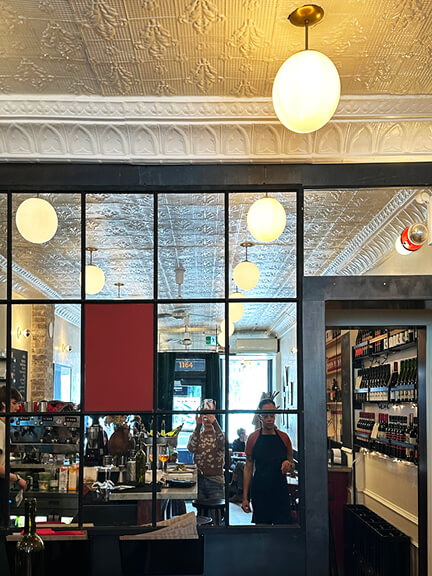
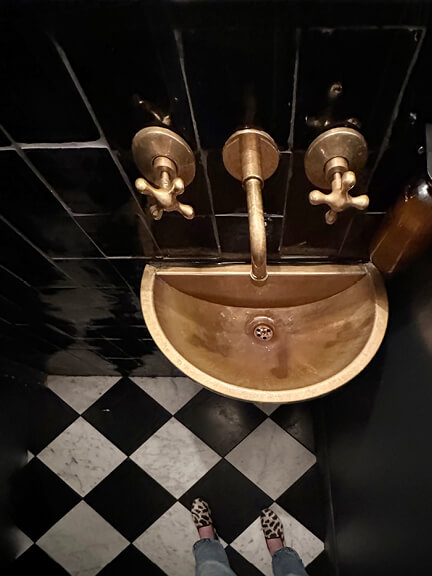
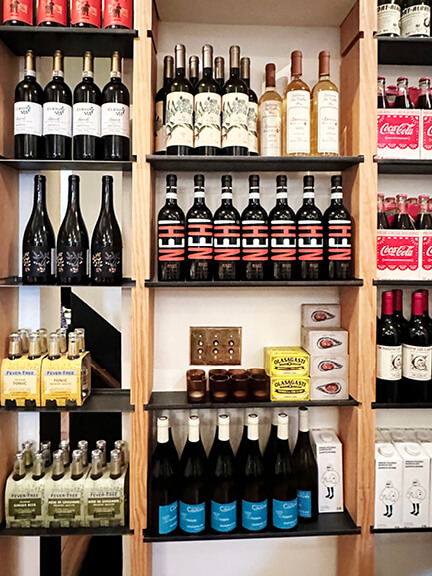
Shoes & Floors
Shoes and floors—my favorite pastime. A good flooring choice sets the tone for any space. At Stock TC, a simple square marble mosaic is punctuated by black and white terrazzo circles with dark grout (read: durability) in the upscale grocery and pre-made food section. In the stairwells and other parts of the retail store, colorful terrazzo—green, black, yellow, and red—creates a bold mix of hues and shapes.
At the Toronto Public Library entrance, a pristine mosaic of white and green caught my eye. I couldn’t tell if it was original or made to look that way—probably the latter—but the green echoed the aged metal on the doors.
At The Webster, great flooring (and shoes) are a given. A white-and-black curved terrazzo pattern plays host to my shiny silver metallic flats. Over at Urban Island in Rosedale, a cheeky message greets you at the pink storefront entry: “hello lover.”
And finally, more from Stock TC: the marble continues upstairs from the grocery below, refined with white marble and warm wood in the restaurant. I love a little cohesion
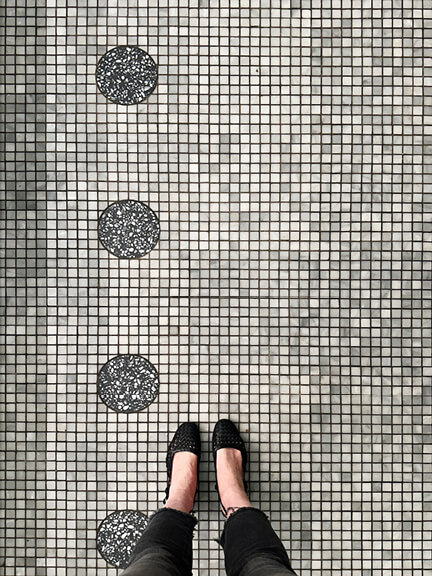

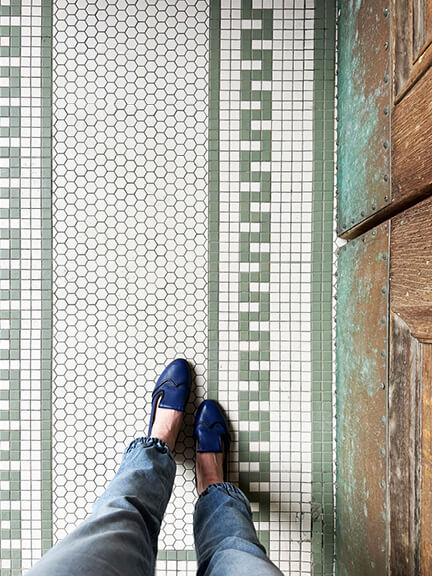
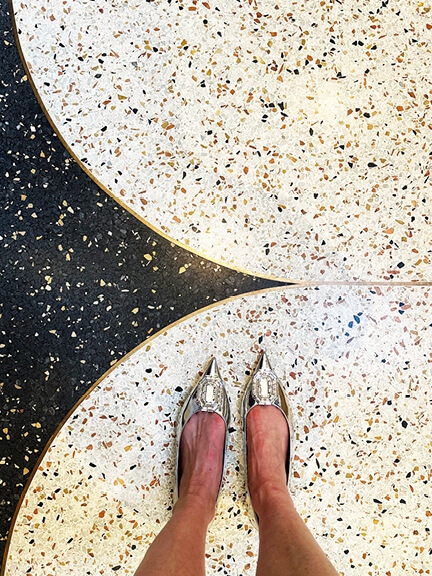
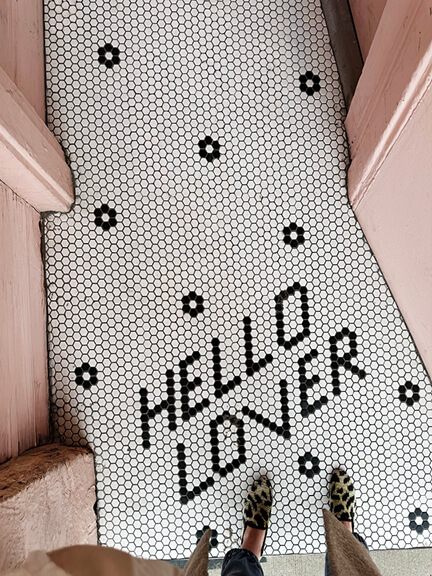
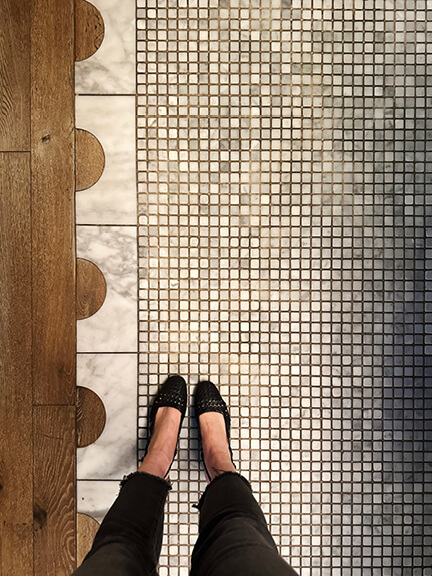
Repurposed, Reframed, Reimagined
From luxury fashion houses nestled in 19th-century brickwork to quiet residential blocks lined with Victorian rhythm and Romanesque grandeur, the city wears its layers well. Whether you’re there to shop, study, or simply look up, the architecture rewards attention. And for anyone interested in historic home design inspiration, it’s a reminder that thoughtful updates don’t erase the past—they give it new context. See more of our New England historic home design work here.
